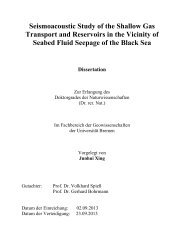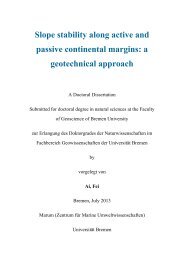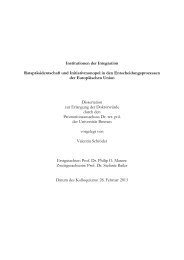aus dem MARUM und dem Fachbereich Geowissenschaften der ...
aus dem MARUM und dem Fachbereich Geowissenschaften der ...
aus dem MARUM und dem Fachbereich Geowissenschaften der ...
You also want an ePaper? Increase the reach of your titles
YUMPU automatically turns print PDFs into web optimized ePapers that Google loves.
MARIA S. MERIAN-Berichte, Cruise 20, Leg 4, Bridgetown – Freeport, 15.3.2012 – 7.4.2012<br />
Consequently the course was deviated to the west towards the escarpment but again the<br />
bathymetry map displayed no mo<strong>und</strong> structures but an impressive canyon above the escarpment.<br />
As a result the area surro<strong>und</strong>ing the first coral findings were mapped in detail.<br />
During the transect to the second working area, which was approximately 100 km south,<br />
Multibeam and PARASOUND sub-bottom profiler data were collected. They document a<br />
seascape of cliffs and canyons and little sediment cover (Fig. 6.15). The cliffs have a similar<br />
morphological expression as the one in the northern working area with irregular edges and<br />
heights aro<strong>und</strong> 50+ m. They occur on several levels of the strata, indicating a repeated erosional<br />
process at the edge of the Florida shelf.<br />
Fig. 6.15 PARASOUND profile through the rugged area off West-Florida. The layered strata of the Florida<br />
shelf is eroded off by slope failure that leaves behind steep-sided remnants. Boul<strong>der</strong> and rocks<br />
accumulate next the vertical cliffs and mo<strong>der</strong>n sediment is perched on some of the ledges.<br />
6.2.4 The West-Florida Slope: ROV Observations<br />
(André Freiwald, Lydia Beuck, Claudia Wienberg, Dierk Hebbeln, Nico Nowald,<br />
Götz Ruhland)<br />
Numerous 5 to 10-m-high elevations and E-W-facing ridges stretch perpendicular from a 40-mhigh<br />
escarpment (as e.g. seen in Fig. 6.14), suggesting downward transport of rocks and boul<strong>der</strong>s<br />
from the hanging wall of the escarpment (see Fig. 6.11). Two ROV dives focussedg on these<br />
elevations in front of the escarpment at 520-500 m depth (GeoB 16326, 16334), whereas dive<br />
GeoB 16341 investigated the escarpment itself (Fig. 6.11).<br />
The seabed beneath the escarpment is covered by a mixture of muddy to pure sand. The soft<br />
sediment is intensely bioturbated by fish and crustacean burrows. Locally, areas of weakly<br />
rippled sand with pteropod accumulations in the ripple troughs are present. The sedimentdwelling<br />
community consists of cerianthids, solitary scleractinian corals and denser patches of<br />
astrorhizid foraminifer threads. Remains of seagrass are present but in low proportions. The<br />
benthic mobile fauna consists of galatheid crustaceans, Chaceon fenneri and several shrimp<br />
species. The <strong>dem</strong>ersal fish community encountered comprise of Polymixia lowei, Prionotus sp.,<br />
Ophichthus sp. (Fig. 6.16a), Merluccius sp., Chaunax suttkusi and a rajiid. The rugged seabed<br />
topography seen in the PARASOUND data (Fig. 6.14 and 6.15) is made of boul<strong>der</strong> fields<br />
consisting of several types of carbonate rocks such as arenaceous foraminifer packstones.<br />
Apparently, the boul<strong>der</strong>s <strong>der</strong>ive from the upslope escarpment and most likely represent a major<br />
slope failure. The seabed between the 5 to 10-m-high boul<strong>der</strong> ridges consists of sand and the<br />
corresponding soft bottom community as described above. The boul<strong>der</strong> substrate is utilised by<br />
29

















